The Stamp Act of 1765 refers to the tax enforced by the Parliament of Great Britain on the colonies of then British America. The act called for printed materials within the colonies to be standardized using London-made stamp paper with embossed revenue stamps. Such printed materials comprise mostly of legal documents, newspapers, magazines and other types of paper used throughout the colonies.
The new stamp tax system was paid using valid British currency, just like previous taxes. The primary objective was to assist in the burden of paying for the troops stationed in North America, just right after British success in the famous global military conflict, the Seven Year’s War. Because the British government strongly believed that the colonies were those who benefitted the most from the war, they should play their part by paying a portion of the expenses.
The Seven Years War
What led to the creation of the Stamp Act of 1765 was the British “Pyrrhic Victory” in the Seven Years War, or as British America called it the “French and Indian War.” It was a very costly war, that the British National debt nearly doubled. The prospect of keeping about ten thousand regular British soldiers positioned in the American colonies after the war assured that post-war costs and expenses would remain high. The primary objective for retaining such a huge force was simply to prevent from demobilizing it. Most of the officers had good connections everywhere in the Parliament, and they probably did all they could so they will not be out of work. This scenario may have supported the need to retain a peacetime force, but because the British were very reluctant with the idea of standing armies at home, they felt that it would be much better garrisoning them elsewhere.
A good number of the army stationed in North America would prove to be a good strategic move as Great Britain just acquired the vast territory that was New France during the 1763 treaty. Troops would naturally be needed to maintain total control of a new empire. Pontiac’s Rebellion of May 1763, was an uprising staged by Native American Indians directed towards the continuing Anglo expansion, only reinforced the need for the strategic move. There were accounts that Pontiac’s Rebellion forced the hand of Britain, which led to the decision of garrisoning troops in greater North America. This proved to be false as the decision was already made even before the uprising.
Politics
George Greenville, the newly proclaimed prime minister in April 1763 spearheaded the task of looking for ways to pay for large armies during peacetime. To raise the taxes in Britain herself was totally out of the question, as virulent protests of another tax called the 1763 cider tax whipped throughout the landscape, which had the previous Bute ministry hanging in the balance. The new Grenville ministry had to look elsewhere on distant shores for a solution; they saw that American colonists would be a good prospect, and so they went on with their plan.
Also, politicians in London had always argued that American colonists should do their part and contribute to the defense effort, since it was the colonist’s defenses that were at stake. As long as the French continues to exist in America, the threat would always be there. This part especially, had given Parliament little trouble, as the colonial legislatures were quick to respond and provide assistance. However, the help or assistance given was in the form of raising colonial militias. This proved contradictory to the plan that British parliamentary had in mind. Things got worse as the colonial militias during the peace of 1763 were quickly abandoned. It created a stalemate that eventually led to other options, like the Stamp Act of 1765.
Resistance
This idea was met with great resistance throughout the colonies. Colonists justified their resentment mainly due to the absence of representation in the parliament and the effect that they did not have influence over the various taxes that were being raised and how they would be systematically levied and spent. Most colonists viewed this as a violation of their rights; Englishmen taxed without their consent. And if there indeed was, it was one that only colonial legislatures could ever grant.
Various assemblies setup by the colonies sent their petitions, which was followed by protests. Led by common colonial landowners and merchants, they found a great opportunity to establish connections primarily though correspondence. This created a loose coalition by colonies from New England to those from Georgia. New York City back then also held the Stamp Act Congress to voice their opposition, petition the parliament and the king. It became the first joint colonial response against British rule. Things heated up as demonstrations from the Sons of Liberty, a political group composed of American patriots, would get out of hand and become violent. This greatly intimidated stamp tax distributors; they resigned from their posts, which meant that this specific tax never materialized.
More opposition
The opposition was never limited to the colonies. Both British manufacturers and merchants pressured Parliament, citing that the valuable exports to the colonies were under constant pressure due to the various economic problems suffered by the colonies. Finally, on March 18, 1766 the act was repealed; but Parliament countered by affirming and strengthening its hold on the job to legislate for the colonies in every way by introducing the “Declaratory Act.” This only made matters worse as colonists became increasingly concerned with the whole agenda of the British Parliament and the direction that things were going. This is among the factors that paved the way for the American Revolution.
Paving the Way
Some phases of the resistance against the act became the staging ground for another important resistance, this time against the Townshend Acts of 1767. And in the American Revolution that followed a decade later, committees that were formed from both sides to voice opposition were meeting on more formal grounds. The colonies also took part with a non-importation agreement known as the Continental Association in 1774. All in all, the ability of these colonies to get their act together for a common purpose, in this case the opposition to the Stamp Act 1765, paved the way for breaking free from British control.

